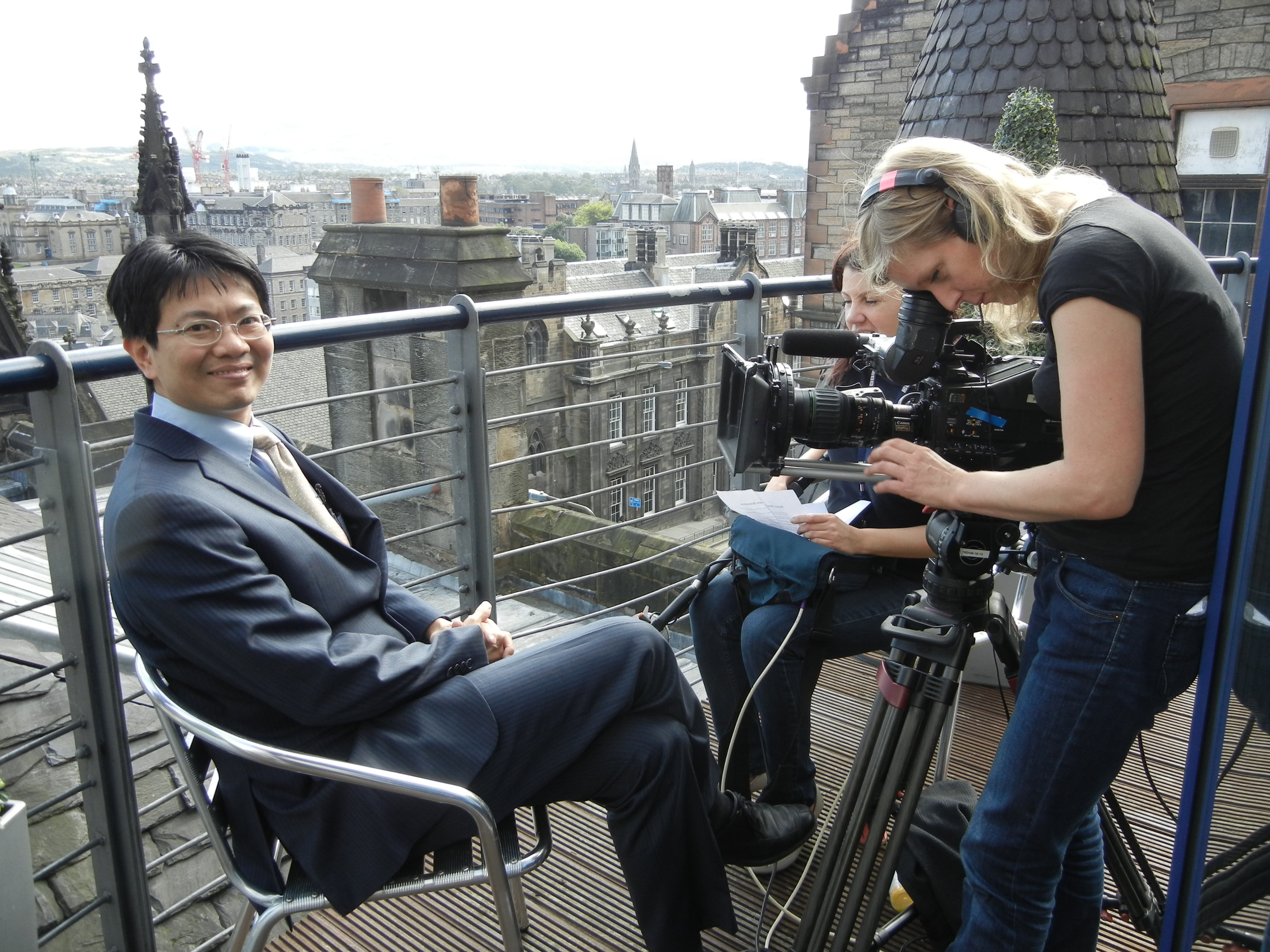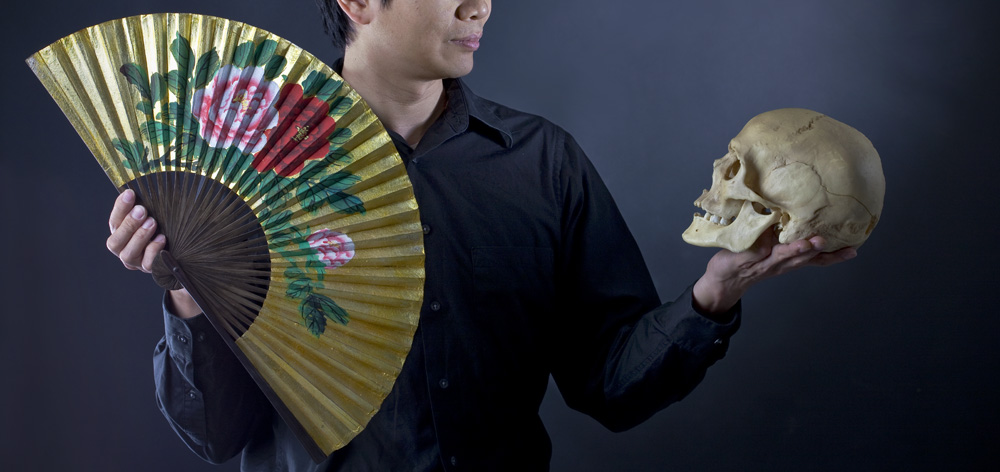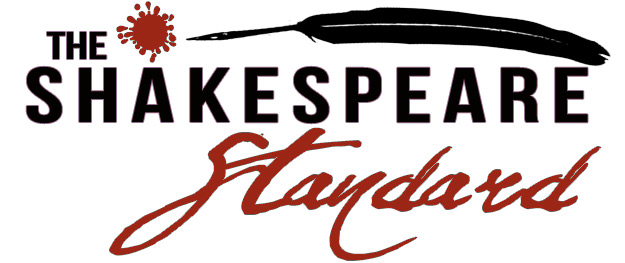This week begins a two-part interview with Professor Alexander Huang of George  Washington University.
Washington University.
He is Director of Dean’s Scholars in Shakespeare Program and Associate Professor in the Department of English, with affiliate appointments in Theatre and Dance, East Asian Languages and Literatures, and Elliott School of International Affairs. He is also part of the GW Medieval and Early Modern Studies Institute (MEMSI). Professor Huang has written several books including: Chinese Shakespeares: Two Centuries of Cultural Exchange (winner of multiple awards including the MLA Scaglione Prize); Weltliteratur und Welttheater: Ästhetischer Humanismus in der kulturellen Globalisierung; Shakespeare in Hollywood, Asia and Cyberspace, co-edited with Charles Ross; and Class, Boundary, and Social Discourse in the Renaissance co-edited with I-chun Wang and Mary Theis. He is a general editor of The Shakespearean International Yearbook, and has guest-edited special issues of the journals Shakespeare, Asian Theatre Journal, and Borrowers and Lenders: The Journal of Shakespeare and Appropriation. We interviewed Professor Huang about about his upcoming projects, teaching at GWU, and the Washington DC theatre scene for the 9 March edition of “A Great Feast of Languages |Interview with Professor Alexander Huang, George Washington University |Global Shakespeare News” and Josh Magsam reviewed the Global Shakespeares website for the 23 February edition of “A Great Feast of Languages | Exploring the MIT Global Shakespeares Site | Global Shakespeare News.”
Professor Huang is also a co-founder of the ambitious, impressive, and comprehensive website Global Shakespeares, the focus of this week’s feature.
Please briefly introduce the Global Shakespeares project.
Co-founded by Peter Donaldson (MIT) and Alexander Huang (George Washington University), Global Shakespeares is an open-access, non-profit digital archive of vetted video and textual materials pertaining to twentieth- and twenty-first century performances of Shakespeare’s plays by U.K., U.S., Latin American, European, Middle Eastern, South Asian, and East Asian artists. Supported by the collaborative effort of researchers and students at MIT, George Washington University, and a number of other institutions, the archive contains an online video teaching module (with more modules in the works), metadata records, subtitled full performance videos, video highlights, images, texts of stage and screen adaptations in English and world languages, peer-reviewed essays, interviews of directors and performers, a dynamic historical timeline and world map, and bibliography. The project is guided by an international advisory board of Shakespearean scholars, and counts among its contributors a team of regional editors covering the U.S., U.K., Brazil, the Middle East, Latin America, Europe, India, and East and Southeast Asia.
What is the ultimate aim of this project? And who is the intended audience?
We have made primary research and teaching materials available to a broad audience in the forms of video footage (some with English subtitles), play scripts in the original language and English translation, bibliography including reviews, and interviews. The ultimate aim of Global Shakespeares is to internationalize Shakespeare in performance and Shakespeare studies, to help artists, educators, researchers and students form a transnational network, and to inspire new performances. We have achieved these goals through adoption of the project for class use, through workshops and conferences in Europe, the U.K., U.S., Canada, Asia, and Brazil, and through our community and outreach efforts. For example, I used a touchscreen exhibit to showcase key adaptations and the history of Chinese reception of Shakespeare when I served as video curator for the Folger Shakespeare Library exhibit on “Imagining China: Views from Europe 1550-1700” (curated by Timothy Billings), Sept. 2009-Jan. 2010; more than 5,000 visitors visited the exhibition.
The open-access project is intended for researchers, instructors, students, directors, performers, and the general public interested in globalization and Shakespeare. The project and its online video learning module of King Lear are being used in dozens of university and high school courses in the U.S., U.K., Canada, China, Brazil, and Japan. We plan to launch more online video learning modules on more performances. “Global Shakespeare” courses are proliferating at the undergraduate level in the U.K., Canada, and U.S., and in high schools including Polytechnic School in Pasadena and Menlo School in California, because they answer the demand for international coverage, the demand to sustain traditional canons, and the need to address an increasingly diverse student body. Over the next decade, Shakespeareans will need to become more informed about both Anglophone and non-Anglophone traditions of performance, which is why we co-founded Global Shakespeares.
How did you become involved? What is your particular role in the Global Shakespeares project?
I consider myself a researcher with the mind of an archivist and an agent of Shakespeare and world cultures in the field. Over the past 15 years I have been writing about Shakespearean adaptations, beginning with Chinese, Taiwanese, and Sinophone traditions of interpreting English and Shakespearean drama and gradually expanding into East Asian, Asian American, European and British histories of reception. Along the way, I have amassed a growing collection of performance videos, scripts, metadata, rehearsal notes, audiences’ letters, and interviews. By word of mouth my colleagues both locally and elsewhere often asked me to loan them videos and other materials from my personal archive for their research and teaching. Before long, I was no longer able to keep up with the demands.
I believe in open access, and have always had a strong desire to make sharing primary research material easier and build an online video archive. I hold a certificate in educational technology from a Mellon Foundation-funded program at Middlebury College, and am proficient in digital video processing and web design. While a graduate student at Stanford, I helped to design online German proficiency tests and worked with Patricia Parker to launch the Stanford Shakespeare in Asia initiative and website in 2004. The Stanford project served as a basis for my later digital projects. After I left Stanford, I no longer had the same level of institutional and laboratory support for digital video projects, and began searching for a new partner.
Peter Donaldson, who is a pioneer in studying and teaching Shakespeare on film and has built tools such as XMAS for researchers and students to write multimedia essays in reference to DVDs, also happened to become interested in Shakespeare in the non-Anglophone world. He built the renowned MIT Shakespeare Electronic Archive, a text-image database, in the 1990s, and was ready to move on to experiment with digital videos.
When we found each other, it was a match made in heaven. When we started, no open-access digital performance video archive existed. We worked closely with web designer Suzanne Lisanti and her team and project manager Belinda Yung at MIT to establish best practices and templates.
We began a series of almost weekly conversations over the years since the World Shakespeare Congress in Brisbane, Australia, in the summer of 2006. We then co-founded an open-access online digital video archive called Shakespeare Performance in Asia (SPIA) in 2007, which was built around my personal research video archive, assembled over many years of field work. SPIA covered what we considered to be the most innovative stage adaptations of Shakespeare’s plays in Japan, Korea, Taiwan, Singapore, Hong Kong, China, and India. In 2010 we co-founded Global Shakespeares and significantly expanded our coverage of international performance traditions and genres.
I am currently a research affiliate in Literature at MIT. My role in Global Shakespeares is co-founder and co-editor. I have translated, and worked with collaborators to translate, Mandarin Chinese, Cantonese, Taiwanese, Japanese, and Korean materials for the project. I am also regional editor for Asia. Together with Peter Donaldson, we oversee acquisitions of videos, permissions and copyrights, annotations, vetting and peer reviewing processes, and recruitment of and collaboration among editors. My initial area of emphasis was Asia, but I have acquired materials from Canada, the U.S., U.K., Europe, Latin America, and Asia.
And can you tell me a bit about working with Professor Donaldson on this project? How you do each contribute? Where do your interests and skills converge, and where do you add unique touches?
It has been an honor and pleasure to work with Peter Donaldson. As many of us in the field of Shakespeare studies know, Peter is one of the most visionary, earnest, and collegial scholars, providing friendship and leadership along the way. Our interests in the (then nascent) field of global Shakespeare converge, but we bring complimentary skill sets to the project. Peter brings to the project his expertise in digital humanities, film studies, and Shakespeare studies. He has played a key role in internal fundraising and establishing the MIT Global Shakespeare curricular initiative (which I now participate in), and worked closely with MIT programmers. I bring to the project my background in digital humanities, comparative literature (German / French / English / East Asian studies), performance and Shakespeare studies, international field research experience, as well as foreign language skills. I was involved in a number of rights negotiations with various partners and directors.
Both of us have been involved in key decisions about the functions, purposes, and scope of the project, and designs of the public user and researcher interfaces. We have learned from each other and enriched each other’s research programs and courses. Peter has begun giving talks on Japanese Shakespeare and written a forthcoming journal article on how a recent Japanese adaptation of Hamlet repurposes and conducts a kind of dialogue with the account of the Fall of Troy in Shakespeare’s play (2.2.423-550), invoking the Japanese epic Heike monogatari (Tale of the Heike). I have also expanded the scope of my research, drawing on the archive we built and the experience we had. For example: “Global Shakespeare 2.0 and the Task of the Performance Archive.” Shakespeare Survey 64 (2011), 38-51; and “Shakespeare and Translation.” The Edinburgh Companion to Shakespeare and the Arts, ed. Mark Thornton Burnett, Adrian Streete, and Ramona Wray. Edinburgh: Edinburgh University Press, 2011), 68-87.
Our collaboration extends beyond the project. We have co-written the statements on the website, co-led several workshops at major conferences (including the 2013 MLA in Boston), and co-written a forthcoming article on King Lear, spirituality, and modern stage and film versions.
The collection of videos and video clips is impressive! How do you solicit and compile these resources? Do some of these just find you? Were there any major surprises during the process?
Collecting these videos and video clips is a labor of love. While they may appear “rootless” in their existence as online videos, I must emphasize the rootedness of the process. I travel extensively to different parts of the world to do field research, give invited lectures, attend conferences, interview directors and collect performance videos and texts along the way. I also spend a great deal of time soliciting materials over phone and email, compiling these resources on a dynamic world map (part of which is available on Global Shakespeares), plotting them on a timeline, and recording and vetting metadata on a large Excel spreadsheet. As our project and its reputation and exposure grew, some videos began to find us. [You can read more about Professor Huang's travels and see his picture diaries in his travel blogs, here and here].
What is your favorite feature on the Global Shakespeares site?
My favorite features are (1) the cross-search function that links Global Shakespeares’ coverage of multiple regions of the world and (2) our new online learning modules. Our expanding coverage and cross-platform federated search function have shown us surprising links between performances from cities that are, well, worlds apart.
Recently we have launched the first of a series of media-rich online, English-language introductions to major international productions of Shakespeare’s plays for use in education and for the general public. These modules have been designed for anyone with an interest in Shakespeare and theatrical performance around the globe, and optimized for use as units in high-school AP and college classes in Shakespeare and theater. Each module includes full video of the production with translation, introduction, production “chapters,” study questions, and interactive exercises in which students define and annotate virtual clips from the productions and write multimedia essays using the clips and notes they have made. Our first module focuses on a solo Beijing opera adaptation of King Lear by Wu Hsing-kuo.

Many Westerners who hear “Shakespeare” and “Asia” probably do not go beyond Kurosawa. How can the layperson move beyond Kurosawa? Can you explain what they are missing?
Akira Kurosawa is a master filmmaker, visual artist, and storyteller, which is why his Throne of Blood (1957) and Ran (1985) are so popular. However, his postwar film versions of Macbeth and King Lear are not the earliest or the only Shakespeare films from East Asia. There is much more to Asian interpretations of Shakespeare than Kurosawa, on stage and screen, in manga, fiction, painting, and many other genres. In Japan, Yukio Ninagawa’s widely toured productions are a staple at international venues and festivals.
There are a few performances and films that can take you beyond Kurosawa. Check out these gorgeous adaptations.
1. Chicken Rice War, dir. Cheah Chee Kong (Singapore, 2000)
In the marooned rehearsal of a school play in an urban comedy, a stuttering student asks their drama coach if he could play Romeo. A young lady rolls her eyes and challenges her classmate: “What makes you think that you can play Romeo? You don’t have the looks, and you can’t even speak properly.” She is quick to point out that the other student, originally cast for the male lead, is eminently more qualified even if he cannot remember his lines: “Nick, on the other hand, looks like Leonardo DiCarpio. That’s why he’s Romeo.” Her protégée promptly supports her cause and leaves the aspiring thespian speechless. Her argument about dramatic verisimilitude is obviously flawed, but her identification with select embodiments of the global “West” (including Shakespeare’s soft power and Tiffany jewelry’s sway in commencing a romantic relationship) compels us to consider cultural globalization from a local perspective. Chicken Rice War parodies Hollywood rhetoric and global teen culture by commenting on the popularity of Baz Luhrmann’s 1996 film William Shakespeare’s Romeo + Juliet which starred Claire Danes and Leonardo DiCaprio and brought the classic tale of power and passion to modern-day Verona beach.
2. The Banquet, or Legend of the Black Scorpion, dir. FENG Xiaogang (China, 2006)
This martial-arts feature film in Mandarin Chinese gives Gertrude and Ophelia, traditionally silenced women characters in Hamlet, a strong presence, though the centrality of the Gertrude figure in the film’s narrative has been seen as problematic by some critics. As a bold period epic, the film is informed by rich intertextual traces of diverse themes from Shakespearean and Chinese sources.
3. Maqbool, dir. Vishal Bhardwaj (India, 2004)
Hailed as a “Macbeth meets The Godfather” film, this defies convenient categorization because it combines Bollywood gangster film, Muslim social drama, ethnography, and postmodernist artwork. The closing scene in Maqbool is connected to Luc Besson’s Léon (1994) through its visual strategies.
4. The Tempest, dir. OH Tae-suk (Edinburgh, U.K., and Seoul, Korea, 2011 and 2012)
Renowned South Korean stage director and playwright Oh Tae-suk mounted his version of The Tempest to critical acclaim in Edinburgh. His production offers, among other creative twists, a two-headed Caliban played by two talented actors in a suit with a pouch. Recast as a vexed character capable of recognizing his own limitations, Prospero was often challenged by the spiky-haired Miranda and worked closely with Ariel, a shaman, to manage domestic affairs. Ariel sometimes assumed a motherly role to augment the aging father’s tenuous relationship with his teenage daughter. The production deliberately avoided the tired allegory of colonialism that has often been associated with The Tempest in modern times. The performance ended on a high note. Instead of a staff and books—symbols of authority and the archival source of knowledge in an ontological sense—Prospero carried a folding bamboo fan (hapjukseon)—a symbol of artistry and intellectualism—when he was not at the drum. The folding fan is an integral part of a gentleman’s accessories and is a more versatile prop and powerful symbol than books.

Follow-up Question: Why Shakespeare & Asia? What about his plays appeal to Asian theatre and culture?
Shakespeare Performance in Asia (SPIA), also co-founded by Huang and Donaldson, is now a part of Global Shakespeares. We began with Asia not because of regional exceptionalism or bias, but because Asian performances over the past decades have become increasingly prominent internationally and transformed our understanding of Shakespearean tragedy and comedy.
The past decades have witnessed diverse and bold re-imaginings that gave rise to productive encounters between the ideas of Asia and of Shakespeare. The beginning of the new millennium is for Asian cinematic Shakespeares as the 1990s were for Anglophone Shakespeare on film — a rich environment for cross fertilization. Shakespeare has been a part of the film and popular cultures of various Asian countries, with Romeo and Juliet, Macbeth, and Hamlet at the center of cinematic imaginations. Macbeth and King Lear have diagnostic significance in modern East Asia: Lear offers material for exploration of the emerging political order after World War II and Macbeth has been used to help audiences overcome the trauma of wars.
Shakespeare’s other plays also appeal to Asian audiences. The racial issue disappears by being recast as uneasy familial relations in Japanese interpretations of Othello, and it is made hauntingly present through its absence from radically localized, colorblind, Korean performances that seek to redress the wound of Japanese colonization.
In the Chinese tradition of performing The Merchant of Venice as romantic comedy, the play is often retooled as an adventure of an attractive woman lawyer or an outlandish tale involving a pound of human flesh. This framework has activated elements of the play that, over several centuries of Anglo-European readings, have become obscure to communities that gravitate towards the ethics of conversion as a key site of tension in the narrative.
Other examples of reconfigurations of the center and the periphery abound. These works have led to the transformation of traditions occurring in both directions at once. Take another play, Hamlet, for instance. East Asian stage and cinematic traditions—with a useful historical distance from Anglophone cultures—have ignited new artistic and critical energy by dispossessing the modern Hamlet’s post-Enlightenment “intransitive inwardness” created by a blind spot in the West, as analyzed by Margreta de Grazia’s Hamlet without Hamlet (2007). We learn a great deal about Shakespeare and our century when we are confronted with these fresh perspectives.
Are there geo-political areas where it seems Shakespeare has little or no significance? What are the limits of Global Shakespeares?
There are countries and regions in the world where Shakespeare does not figure prominently in their local cultural history. From a collector’s point of view, this is archival silence. Archival silence is useful because it compels us to rethink our criteria, frame of reference, and historiographical assumptions. For example, while post-colonial critics commonly privilege works that critique the role of Western hegemony in the historical record of globalization, the meanings of Shakespeare today are not always determined by post-colonial vocabulary or the discourses of globalization.
Well, I am disappointed, and relieved at the same time, by the fact that there are no significant “Shakespeare traditions” in the Antarctic, Greenland, or large swaths of Sub-Saharan Africa (save for South Africa). The lack of a coherent, constructed Shakespeare tradition does not mean there are no local engagements with Shakespearean material. Artistic, political, and scholarly traditions of Shakespeare in any given location should be understood in different frameworks. While there are rich references and allusions to Shakespeare and his characters in Mexican cinema, there is no local scholarly tradition of Shakespeare studies, according to Alfredo Michel Modenessi who serves on our advisory board (of Global Shakespeares).
Another example. During the Cultural Revolution in China, Shakespeare was banned along with other Western authors but was simultaneously evoked and frequently referenced by Mao Zedong in his political arguments.
Your question suggests that you are eager to hear about the limits of Shakespeare’s global reach. Global Shakespeares as a critical concept and a research project have changed how we think about Shakespeare’s legacy and Shakespeare’s place in different cultural marketplaces around the world. However, “global Shakespeare” as a concept is limited—though simultaneously energized — by the competing pull of tendencies to privilege local over macro-histories, and “global Shakespeare” as a project reveals multiple geographical areas where there are no significant “Shakespeare traditions.”
One of my goals of co-founding Global Shakespeares is to eventually kill “global Shakespeare” as unproductive shorthand. The digital global age and its attendant imagery replay the message of a Eurocentric or North American centered world as a universal on an even grander scale, though often without the heroic narrative of conquest. What global Shakespeare might be, in an age in which communication is worldwide, instantaneous, and image-rich, global Shakespeare can be a site of conflict as well as new artistic and research opportunities. Recognised for its artistic creativity and now established as a field of scholarly inquiry, global Shakespeare remains an ostracizing label, categorizing a group of cultural products that can conveniently be cordoned off. Even though Shakespeare’s tragedies, comedies and history plays undeniably intertwined with the history of many theatrical traditions, global Shakespeare does not quite fit comfortably within any discipline.
With the dramatically increased availability of primary research material through digital video archives, the field should be able to move toward a mode of inquiry that inherently considers performances in comparative contexts. As the field matures, Shakespeare in performance may no longer require such qualifying adjectives as Asian, European, African, or even global.
Thank you so much for agreeing to this interview and introducing Global Shakespeares!
The Shakespeare Standard is an online Shakespeare forum dedicated to bringing the online community Shakespearean news about performance, scholarship, and multimedia every day. Please join us here at our site or on Facebook or Twitter to discuss the latest things of interest in Shakespeare news. If you would like to share more information about a Global Shakespeare or non-Anglophone Shakespearean production, film, website, etc., please email me at colleenekh@gmail.com with the subject line “Global Shakespeare.”







